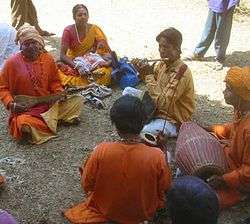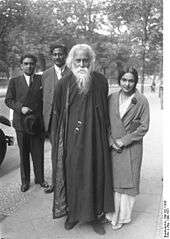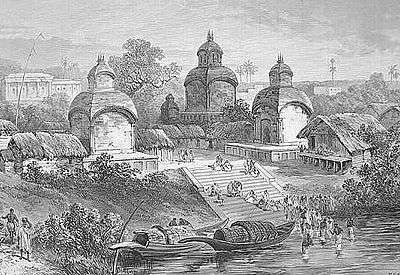Culture of West Bengal


The culture of West Bengal is an Indian Culture which has its roots in the Bengali literature, music, fine arts, drama and cinema. People of West Bengal share their cultural heritage with the neighbouring Bangladesh (erstwhile known as East Bengal). West Bengal and Bangladesh together form the historical and geographical region of Bengal, with common linguistic and ethnic backgrounds. Besides the common cultural characteristics, different geographic regions of West Bengal have subtle as well as more pronounced variations between each other, with Darjeeling Himalayan hill region and Dooars showing particularly different socio-cultural aspect.
West Bengal's capital Kolkata—as the former capital of India—was the birthplace of modern Indian literary and artistic thought,[1] and is referred to as the "cultural [or literary] capital of India".[2][3] The presence of paras, which are cluster of neighbourhoods that possess a strong sense of community, is characteristic of West Bengal.[4] Typically, each para has its own community club and, on occasion, a playing field.[4] Residents engage in addas, or leisurely chats, that often take the form of freestyle intellectual conversation. However, with the growth of apartments, expansion of neighbourhoods and rapid urbanization, this culture is on decline.[5][6] West Bengal has a long tradition of popular literature, music and drama largely based on Bengali folklore and Hindu epics and Puranas.
Religion, specially Hinduism, the principal and predominant religion of the state, plays a vital role in the culture of West Bengal. Durga Puja, a five-day annual autumnal celebration in honour of Hindu goddess Durga, is the biggest festival of the state. Kali Puja, worshiping the guardian deity of Bengal, is also celebrated with great enthusiasm. Since Bengal is a part of India, its culture has been an amalgamation of predominant Hindu culture with the secular Bengali culture which have drawn its inspiration from the modern Western culture.
Literature

The Bengali language boasts a rich literary heritage, shared with neighbouring Bangladesh. West Bengal has a long tradition in folk literature, evidenced by the Charyapada, Mangalkavya, Shreekrishna Kirtana, Thakurmar Jhuli, and stories related to Gopal Bhar. In the nineteenth and twentieth century, Bengali literature was modernized in the works of authors such as Bankim Chandra Chattopadhyay, Michael Madhusudan Dutt, Rabindranath Tagore, Kazi Nazrul Islam, and Sharat Chandra Chattopadhyay. Coupled with social reforms led by Ram Mohan Roy, Swami Vivekananda, and others, this constituted a major part of the Bengal Renaissance.[7] The middle and latter parts of the 20th century witnessed the arrival of post-modernism, as well as literary movements such as those espoused by the Kallol movement, hungryalists and the little magazines.[8] Jibanananda Das, Sukumar Ray, Sukanta Bhattacharya, Bibhutibhushan Bandopadhyay, Tarashankar Bandopadhyay, Manik Bandopadhyay, Narendranath Mitra, Subodh Ghosh, Ashapurna Devi, Shirshendu Mukhopadhyay, Buddhadeb Guha, Mahashweta Devi, Samaresh Majumdar, Mani Shankar Mukherjee, Dinesh Das, Sanjeev Chattopadhyay, Syed Mustafa Siraj, Sunil Gangopadhyay and Joy Goswami among others are well-known writers of the 20th century.
Theater and films
Among other types of theater, West Bengal has a tradition of folk drama known as jatra.[9][10] Kolkata is the home of the Bengali cinema industry, dubbed "Tollywood" for Tollygunj, where most of the state's film studios are located.[11] Its long tradition of art films includes globally acclaimed film directors such as Academy Award-winning director Satyajit Ray, Ritwik Ghatak, Mrinal Sen, Tapan Sinha, and contemporary directors such as Aparna Sen, Buddhadeb Dasgupta, Goutam Ghose, Koushik Ganguly, Rituparno Ghosh, Anjan Dutt and Srijit Mukherji.[12]
Architecture

Architecture of Bengal includes various types of motifs as well as it represents the different eras of the region. Terracotta, Islamic, Indo-Saracenic, British architecture etc. include many temples, mosques, churches, palaces, forts, monasteries and rajbaris. British Calcutta was known as the 'City of Palaces', while modern city has large number of apartments and housing complexes which characterize all metropolis of the world. Bengali village housing is noted as the origin of bungalow.
Fine arts

There are significant examples of fine arts in Bengal from earlier times such as terracotta art of Hindu temples, Kalighat paintings etc. Bengal has been the harbinger of modernism in fine arts of India. Abanindranath Tagore, called the father of Modern Indian Art had started the Bengal School of Art which was to create styles of art outside the European realist tradition which was taught in art colleges under the colonial administration of the British Government. The movement had many adherents like Gaganendranath Tagore, Benode Behari Mukherjee, Ramkinkar Baij, Jamini Roy and Rabindranath Tagore. After Independence, important groups like the Calcutta Group and the Society of Contemporary Artists were formed in Bengal which dominated the art scene in India. Graffiti cannot be generally categorised as a fine arts or aesthetic creation, but it has become an inseparable part of popular street-art. It is mainly for political propaganda. Walls are "captured" for fixed numbers of years, and graffiti over-painting is tantamount to political transgression. Generations of political graffiti artists have been at work on Kolkata's walls, producing slander, witty banter and limericks, caricatures and propaganda. However, such acts being clear cases of defacing private property, the Calcutta High Court ruled to ban political graffiti from private properties without express consent of the property owner. Graffiti lives on in "club" walls, unclaimed property walls, and the occasional flouting of the order. Graffiti artists have become a part of Kolktata's heritage. Many house owners now welcome them to paint on their walls so that these are not captured by political parties. Social messages like AIDS awareness, environmental issues etc. are now getting more popularity.
Music and dance
The Baul tradition is a unique heritage of Bengali folk music, which has also been influenced by regional music traditions.[13] Other folk music forms include Gombhira, Bhawaiya, kirtans, and Gajan festival music. Folk music in West Bengal is often accompanied by the ektara, a one-stringed instrument. West Bengal also has an heritage in North Indian classical music. The state is recognised for its appreciation of rabindrasangeet (songs written by Rabindranath Tagore) and Indian classical music. Popular music genres include adhunik songs.[14][15] Since the early 1990s, new genres have emerged, including one comprising alternative folk–rock Bengali bands.[14] Another new style, jibonmukhi gaan ("songs about life"), is based on realism.[16]
Bengali dance forms draw from folk traditions, especially those of the tribal groups, as well as the broader Indian dance traditions. Chau dance of Purulia is a rare form of mask dance. Gaudiya Nritya is a classicalBengali school of Indian dance, originating in Gaur, West Bengal, the ancient capital of the Bengal region. Various forms of Indian classical dances are patronised, as are dances set on the songs of Tagore and Nazrul.
Attire
Though Bengali women traditionally wear the sari and shalwar kameez, Western attire has gained acceptance among younger and professional women.[17] Western-style dress has greater acceptance among men, although the traditional costumes like dhoti, panjabi, kurta, sherwani, pyjama and lungi are seen during weddings and festivals like Durga Puja, Saraswati Puja and Eid. Like any other metropolis, Kolkata also has an eclectic mix of western wears with a tinge of ethnic wears. People are found dressed in jeans along with kurtas, or sari along with an overcoat.
Cuisine
West Bengal shares its distinctive culinary tradition with neighbouring Bangladesh, and also borrows from other Indian states. Boiled rice and roti constitute the staple Bengali food, and is served with a variety of vegetables, fried as well with curry, thick lentil soups, and fish, egg and meat preparations of mutton and chicken, and more rarely pork, duck, lamb and beef by certain groups. Sweetmeats are mostly milk based, and consist of several delights including roshgulla, doi, sandesh, rasamalai, amriti, kalo jamun, pantua, rajbhog, gaja, bonde, pithe, mihidana, laddu and chom-chom. Several other sweet preparations are also available. Bengali cuisine is rich and varied with the use of many specialized spices and flavours. Fish is the dominant source of protein, cultivated in ponds and fished with nets in the fresh-water rivers of the Ganges delta. More than 40 types of mostly freshwater fish are common, including carp varieties like rui (rohu), katla, magur (catfish), telapia, bhetki, koi, lyata, tangra, sole, shingi, pabda etc. Chingri (prawn or shrimp), crabs, oysters and shuţki machh (dried sea fish) are also popular. Salt water fish is ilish (hilsa ilisha) is very popular among Bengalis, and it can be called an icon of Bengali cuisine. Various sea fishes like pomfret, bhola are also favourites. Prominent influx of Mughal (biryani, kebab), Anglo-Indian, Continental, Chinese, Lebanese, Thai and other provincial foods has also occurred and thus resulting in a shift in food choice among the younger generation. There are also numerous popular snacks, beverages and street-foods. Cakes and pastries are sold especially during Christmas.
Festivals
People of different religions perform their religious rituals with festivities in Bengal. Durga Puja, Kali Puja, Eid al-Fitr and Christmas are celebrated with enthusiasm across the state.
Durga Puja, the biggest festival of Bengal, is the most vibrant festivities of all. Across the state, especially in Kolkata, temporary pandals are raised and intense celebrations take place to worship the goddess Durga. Hundreds of thousands of people visit the pandals and roads become overcrowded. After four loud and colourful days, idols are carried out in large processions and immersed into rivers or waterbodies amid singing, dancing, water-throwing and fireworks. Whereas Muslims celebrate Eid with not only congregational prayers but also with shopping, gift-giving, lavish feasting and mehndi designs for women and girls.
Apart from these there are numerous other festivals such as Dolyatra (Holi), Saraswati Puja, Kojagori Lakshmi Puja, Rath Yatra, Janmashtami, Jagaddhatri Puja, Shivratri, Vishwakarma Puja, Kartik Puja, Raas Yatra, Ganesh Chathurthi, Eid al-Adha (Bakr-Id), Muharram, Buddha Purnima, Poush Parbon, Gajan, Bhai Phonta, Pohela Boishakh, Ganga Sagar Mela etc. and various other village fairs and seasonal tribal festivals. Secular festivals like Rabindra Jayanti, Independence Day, Kolkata Book Fair, Kolkata Film Festival, Dover Lane Music Festival, Nandikar's National Theatre Festival, Statesman Vintage & Classic Car Rally, International History and Heritage Exhibition, Apeejay Kolkata Literary Festival are also popular within a significant segment of population.
Sports
Sports has its own importance in Bengal. Sports like cricket and football are most popular sports here. Boys and youngsters often play cricket at the street-corners and parks in Kolkata and other towns. Cricket and football can easily be called the life blood of the city. The home town of Eden Gardens, the city can boast of an impartial crowd of cricket lovers who cheer for good cricket even when their side is losing. Over a football match between archrivals Mohun bagan and East Bengal, the city can get divided. Apart from these, golf, kabaddi, kho-kho, polo, tennis are also played. Various outdoor activities like swimming, karate, yoga, cycling, kite-flying, athletics etc have also gained popularity.
Culture of Darjeeling Himalayan hill region
Apart from the major Hindu religious festivals like Diwali, Dusshera, Holi, Ram Navami, the diverse ethnic populace of Darjeeling Himalayan hill region celebrates several local festivals. The Tibetan ethnic groups like the Lepchas, Bhutias, Gurungs, and Tamangs celebrate new year called Losar in January/February, Maghe Sankranti, Chotrul Duchen, Buddha Jayanti, Christmas and Tendong Lho Rumfaat, to name a few, which provide the "regional distinctness" of Darjeeling's local culture from the rest of West Bengal. The region is inhabited mainly by Hindus, Buddhists and Christians.
A popular food in Darjeeling is the momo, a steamed dumpling containing either chicken, mutton, pork or vegetables cooked in a doughy wrapping served with a watery vegetable soup and spicy tomato sauce/chutney. Wai-Wai is a favorite packaged snack of Darjeeling hills comprising noodles which are eaten either dry or with soup. Churpee, a kind of hard cheese made from cow or yak's milk is another popular mini-snack that is both nutritious and a pastime. A form of noodle called thukpa, served with soup and vegetables, is extremely popular in and around the hills of Darjeeling. Chhang and tongba are local alcoholic beverage made from millet.
See also
- Bengal School of Art
- Bengali folk literature
- Culture of Bengal
- Culture of Darjeeling
- Culture of India
- Music of Bangladesh
- Music of Bengal
- Music of West Bengal
- Christianity in West Bengal
- International History and Heritage Exhibition
- Sabarna Sangrahashala
References
- ↑ Chaudhuri, Nirad C. (2001). The autobiography of an unknown Indian. New York Review of Books. p. 269. ISBN 978-0-940322-82-0.
- ↑ Reeves, Philip (5 April 2007). "Calcutta: habitat of the Indian intellectual". National Public Radio. Retrieved 29 January 2012.
- ↑ Noble, Allen and Frank Costa; Ashok Dutt; Robert Kent (1990). Regional development and planning for the 21st century : new priorities, new philosophies. Ashgate Pub Ltd. pp. 282, 396. ISBN 978-1-84014-800-8.
- 1 2 "Kolkata culture: Para". Department of Tourism, Government of West Bengal. Retrieved 9 December 2011.
- ↑ Trachtenberg, P. (15 May 2005). "The chattering masses". The New York Times. Retrieved 26 April 2006.
- ↑ Mukherjee Pandey, Jhimli (1 November 2008). "Presidency old-timers to relive days of canteen adda". Times of India. Retrieved 23 January 2012.
- ↑ Dutt, R.C. (1962). Cultural heritage of Bengal. Calcutta: Punthi Pustak. cited in Sengupta, Nitish K. (2001). History of the Bengali-speaking people. UBS Publishers' Distributors Pvt. Ltd. pp. 211–12. ISBN 81-7476-355-4.
- ↑ "India: The hungry generation". Time. 20 November 1964. Retrieved 24 January 2012.
- ↑ Chakraborty, Ajanta (5 July 2011). "Meet the new Mamata Banerjee". Times of India. Retrieved 23 January 2012.
The jatra industry based out of Kolkata's Chitpur Road has gone through a severe blow with the growth of video parlours.
- ↑ Niyogi, Subhro (26 October 2010). "Red alert For Jatra". Times of India. Retrieved 23 January 2012.
- ↑ Sarkar, Bhaskar (March 2008). "The melodramas of globalization". Cultural Dynamics. 20 (1): 31–51 [34]. doi:10.1177/0921374007088054..
- ↑ Gooptu, Sharmistha (2010). Bengali cinema: 'an other nation'. Taylor & Francis. pp. 2, 172, 181, 187. ISBN 978-0-415-57006-0. Retrieved 24 January 2012.
- ↑ "The Bauls of Bengal". Folk Music. BengalOnline. Retrieved October 26, 2006.
- 1 2 Dorin, Stéphane (2005). "La globalisation du rock vue de Calcutta" [The globalization of rock to Calcutta]. Volume! La revue desmusiques populaires (in French). 4 (1): 144–45. Retrieved 29 January 2012.
- ↑ Shepherd, John (2005). Continuum encyclopedia of popular music of the world. 3–7. Continuum. pp. 70–71. ISBN 978-0-8264-7436-0.
- ↑ Bhattacharya, Malini (2005). "Culture". In Bagchi, Jasodhara. The changing status of women in West Bengal, 1970–2000: the challenge ahead. New Delhi: Sage Publications. p. 105. ISBN 978-0-7619-3242-0. Retrieved 10 February 2012.
- ↑ Yengkhom, Sumati (23 September 2010). "This Puja, buzz over western clothes". Times of India. Retrieved 23 January 2012.